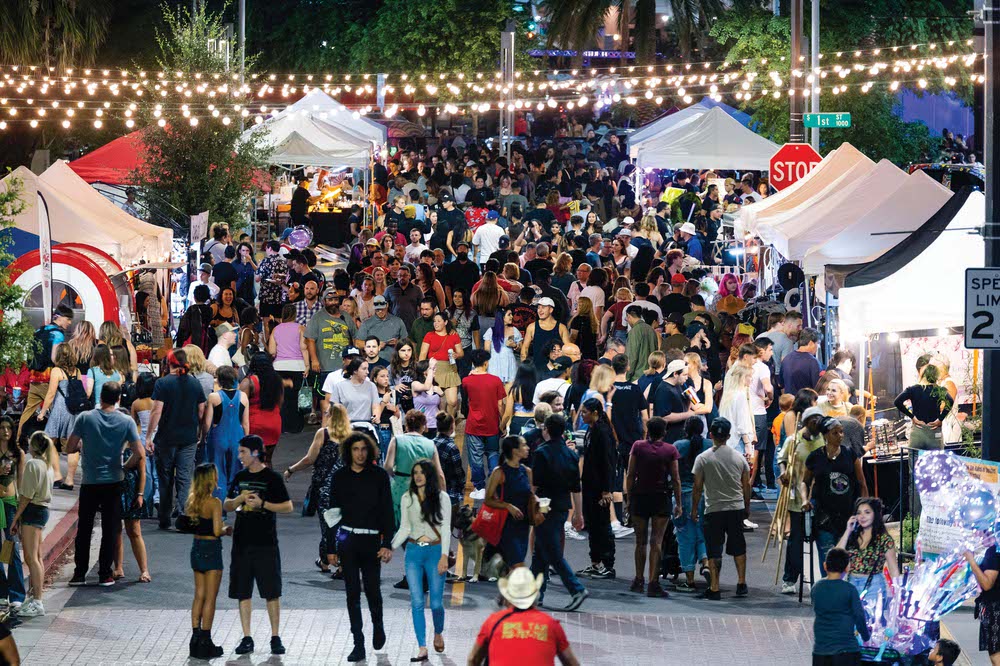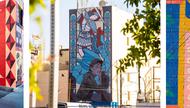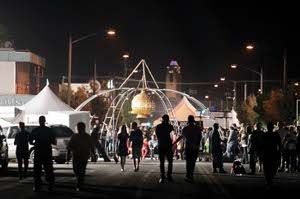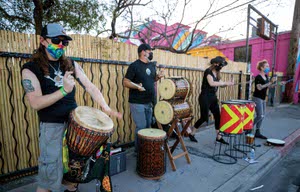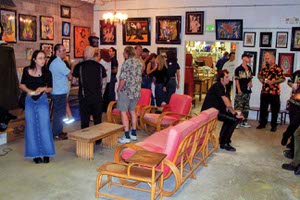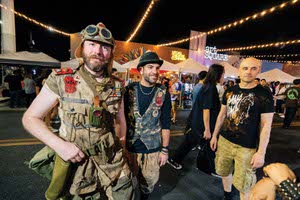The Arts District didn’t exist 20 years ago. Back then, the Downtown Las Vegas neighborhood that now hosts First Friday was a wide-scattered archipelago of galleries and cafés, not the densely packed concentration of galleries and bars we know today.
20 Years of First Friday
In the late 1990s, you could walk a few blocks from an opening at the Contemporary Arts Collective (CAC) gallery on Charleston Boulevard to a spoken word reading at the Enigma Garden Cafe on Fourth Street, though few did.
I lived Downtown in the mid-to-late 1990s, close enough to bike to the Enigma, where I handled the entertainment bookings for a time. I got to know Enigma’s founder and proprietor Julie Brewer, and while hanging out on Enigma’s lush patio I met several locals—among them artist Jerry Misko and attorney Naomi Arin—who would prove instrumental in shaping Vegas’ visual arts scene in the years to come.
And though I moved from Las Vegas to Seattle in summer 2002, I was here long enough to see the opening of the Funk House, an antique shop owned by Cindy Funkhouser, and the Wes Isbutt-owned gallery hive the Arts Factory. I watched as the Arts Factory became the epicenter of local arts in the Valley; eventually, even the CAC moved its gallery there.
“We had [international] attention … plus all of the energy from the Jerry Miskos of the world,” Isbutt says. “All of a sudden, we started getting a thousand people [at our openings]. People were like, ‘What the f*ck is going on?’”
Meanwhile, Brewer, who had stopped handling day-to-day operations at Enigma, began helping her friend Funkhouser to host local art in the Funk House’s back room. Like the Arts Factory, the Funk House had to promote itself on a show-by-show basis; when artists had openings, they needed to print cards and send them to those who had signed up for a mailing list, or give them to local promoters for distribution.
Then Funkhouser took a family trip to Portland, Oregon, to visit her son Jason—a trip that would help transform a sliver of Downtown Las Vegas, from a sleepy assortment of vintage shops and neglected storefronts to a bustling culture and entertainment district that hosts what is arguably this Valley’s most popular and beloved street festival.
While in Portland, Funkhouser discovered that city’s long-running First Thursday art walk.
“Julie and I had been doing First Friday art openings at the Funk House for maybe a year at that point,” Funkhouser says. “I was like, ‘There’s 2 million people in Portland, and there’s almost 2 million people in Vegas; we’re already doing something like this, and there’s no reason it can’t happen.’ Julie and Naomi and [LaserVida arts collective co-founder] Joe [Cartino] all tried to talk me out of it; they said it won’t work, people in Vegas don’t support the arts—problems they’d already experienced.”
Funkhouser formed a nonprofit called Whirlygig to administrate Vegas’ First Friday, with Brewer and Arin as her partners. Brewer, who had worked with numerous artists during her time at Enigma, took care of much of the logistics and community outreach; Arin handled the legal concerns.
The inaugural First Friday event took place in October 2002, with an assist from Misko, who encouraged the neighboring Arts Factory businesses and galleries to stay open that night. Funkhouser asked several artists to set up tables outside her front door. Brewer walked around disguised in an expressionless white mask, blowing bubbles. And Isbutt allowed Funkhouser to create a path of day-glo footprints from the Arts Factory to the Funk House, using a pair of Converse high-tops belonging to Brewer’s husband, Double Down Saloon owner P Moss.
“Jason was wearing them,” Funkhouser says. “Julie and I would roll paint onto his sole, and then he’d take a big step. He was very annoyed, because we were laughing so hard.”
Funkhouser estimates that some 300 people visited the Funk House that night. Isbutt, who maintained a cool relationship toward Funkhouser and Whirlygig (“We never really talked much,” Funkhouser says), quickly recognized the value of First Friday as a promotional tool.
“What First Friday brought was a consistent date and time,” he says. “We didn’t have to tell anyone anymore, ‘It’s June 14, it’s April 27.’ Suddenly, it’s every first Friday [of the month]. That was the big change in the public understanding. … ‘Oh, this is going to happen whether someone tells me or not.’”
Attendance grew quickly. “It pretty much increased monthly,” Funkhouser says. “The word got out, artists wanted to be involved and people wanted to come out.”
The City of Las Vegas, and former mayor Oscar Goodman, took notice. In the months that followed, more and more city resources were allocated to the event. Police presence was stepped up, and assorted vendors were allowed to line the sidewalks.
Before long, crowds thronged the streets around the Arts Factory and Funk House, milling past arts and crafts stands, food trucks and live entertainers. The streets were shut down out of what Funkhouser calls “a matter of necessity.”
And, inevitably, growing pains set in.
“I had recently gone [to the] American Institute of Graphic Arts conference in Phoenix, and guess what they had? First Friday,” Isbutt says. They had been doing it for about 10 years at that time. And it was big; they were drawing probably 10,000 people, and they were having all kinds of problems with police and city infrastructure. When I came back to Vegas, I said, ‘Well, this is the future. This is where we’re going. This is going to happen. We need to address this now, so we don’t have these fights down the line.’
“They went, ‘Yeah, right; go home, sir,’” Isbutt says, chuckling, “And then all of that happened.”
All the difficulties inherent to mounting a monthly street festival came to a head shortly after the start of the Great Recession, Funkhouser says, when a cash shortfall compelled the city and Whirlygig to scale down the event, forgoing the street closures and overtime police. Funkhouser, who was recovering from a cancer battle and open-heart surgery—and still reeling from Julie Brewer’s unexpected death in August 2007—had to manage expectations for a First Friday without the city services attendees had come to expect.
“I had to try to get people to not walk in the streets, because there were cars in the streets,” Funkhouser says. “My health problems had nearly broken me financially, and I was like, ‘I just can’t do this anymore.’”
In 2011, then-Zappos CEO Tony Hsieh acquired the rights to First Friday from Whirlygig. With the influx of cash, the event swelled to gargantuan proportions. Every First Friday, the city shut down five blocks of what had come to be known as the 18b Arts District.
The event’s newly appointed chief managing partner Joey Vanas oversaw a festival that included four stages, 70 curated artists and satellite parking lots with free shuttle service. Tens of thousands of Las Vegans attended the Hsieh-era First Fridays, many of them under 21. Those young attendees seemed more interested in making art than in looking at it, and many of them were likely inspired to do just that.
The expanded festival was a smash. In an October 2011 interview, an optimistic Vanas told me, “We want this thing to be a citywide event. ... The idea from the beginning was to expand out west toward the Smith Center and do another activation there, and then fill in the gaps between the Arts District and Fremont East.”
It wasn’t to be. Hsieh reduced his involvement well before his death in November 2020, and the pandemic shutdown stopped First Friday cold.
Today, the festival is closer to its mid-aughts size. Now confined to the streets and parking lots surrounding the Arts Factory and Art Square—streets that have been rebuilt with wide sidewalks and spacious, brick-lined plazas—today’s First Friday feels more focused, more neighborly. The arts and crafts vendors and food trucks are tucked into street pockets that were more or less built for them, and the live bands and street entertainers have moved into neighborhood venues that didn’t exist 20 or even 10 years ago.
Sometimes I’m there, too. I moved back to Las Vegas in May 2012, only a couple of blocks from where I lived in the 1990s and early aughts, and I can still ride my bike to Downtown gallery openings. I wander through the packed galleries, occasionally buy something from the street vendors (enamel pins, mostly), nosh on something from the food trucks and close out the evening with Night Weapons’ DJ sets at Berlin Bar.
But I can’t visit with the originators. Funkhouser sold the Funk House building some years back. Isbutt has relocated to Colorado. Today, First Friday is operated by the nonprofit First Friday Foundation, whose board of directors includes local business owners, casino and entertainment industry executives and marketing professionals. The event has a dedicated production team. It’s come a long way since high-tops and fluorescent paint.
For his own part, Isbutt, who still owns the Arts Factory building, has mixed feelings about First Friday today.
“First Friday has helped the arts community, but it’s hurt it to some degree, also. When you put it in a festival setting, it takes away from the seriousness of the thing. … It hasn’t turned into the mindset where, if I’m a serious art collector, I’m going to look to buy something,” Isbutt says. “It’s harder to sell art in Las Vegas than other places. But it’s a better art scene, because the artists work harder to do it.”
As for Funkhouser, she’s happy to see First Friday continue, thought she rarely attends the event. When I tell her that the crowds that pack First Friday are mostly made up of kids who had scarcely been born when she launched the event, she’s audibly pleased.
“If they’re getting any bit of art or culture from it, then I’m glad,” she says, then adds with a laugh, “Just don’t tell me if they’re not.”
Click HERE to subscribe for free to the Weekly Fix, the digital edition of Las Vegas Weekly! Stay up to date with the latest on Las Vegas concerts, shows, restaurants, bars and more, sent directly to your inbox!
